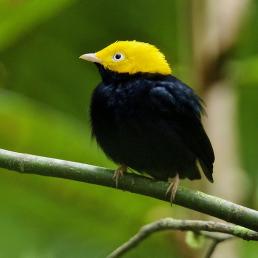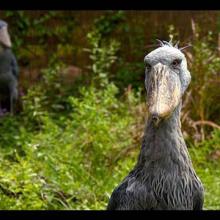

Join BirdNote tomorrow, November 30th!
Illustrator David Sibley and actor H. Jon Benjamin will face off in the bird illustration battle of the century during BirdNote's Year-end Celebration and Auction!
Deep in the dense, remote swamps of Central Africa lives the Shoebill, a massive, blue-gray stork-like bird, standing up to five feet tall. The bird takes its name from its large bill, which is shaped like an oversized Dutch wooden shoe. Although the Shoebill may look comical, its beak is no joke. The edges are sharp enough to behead its prey, which include catfish, lungfish, snakes, and even baby crocodiles. DNA analysis shows that Shoebills are related to pelicans — another group of birds whose oversized beaks are truly awe-inspiring. Shoebills are notably less numerous than pelicans, though, with only 8,000 birds surviving in the wild.
BirdNote®
What in the World Is a Shoebill?
Written by Bob Sundstrom
This is BirdNote.
[Ambient is XC320901 Kretschmer's Longbill]
Deep in the dense, remote swamps of Central Africa lives one of the most peculiar looking of all birds. Picture a massive, blue-gray stork, standing up to five feet tall on long, gray legs. But instead of the stork’s long, tapered bill, substitute a prodigious, stout bill that’s hooked at the tip — and that gives this bird its name.
[Shoebill bill clapping and vocal sounds, http://macaulaylibrary.org/audio/2285, 0.48-54]
Meet the Shoebill, a bird unknown to science until the 19th Century, and the only living member of its family. So named because that comically large bill is, yellow-orange, and shaped like an oversized Dutch wooden shoe. But although the Shoebill looks like it walked right out of a cartoon, its beak is no joke. The edges are sharp enough to behead its prey, which include catfish with hard bony heads as well as lungfish, snakes, and even baby crocodiles. Which Shoebills hunt in the shallows, often standing completely motionless before they strike.
The Shoebill’s physical resemblance to the stork gave it its early name, the Whale-headed Stork. But DNA analysis showed that it’s more closely related to pelicans — another group of birds whose oversized beaks are truly awe-inspiring. Shoebills are notably less numerous than pelicans, though, with only 8,000 surviving in the wild.
Get a look at one on our website, BirdNote.org. I’m Mary McCann.
###
Bird sounds provided by The Macaulay Library of Natural Sounds at the Cornell Lab of Ornithology, Ithaca, New York. [2285] recorded by Marian P. McChesney.
XC320901 ambient sounds recorded by James Bradley, Kenyan Swamp setting.
BirdNote’s theme music was composed and played by Nancy Rumbel and John Kessler.
Producer: John Kessler
Executive Producer: Sallie Bodie
© 2016 Tune In to Nature.org November 2016/2019 Narrator: Mary McCann
ID# SHOEBI-01-2016-11-08 SHOEBI-01
[Shoebill bill clapping and vocal sounds, http://macaulaylibrary.org/audio/2285, 0.48-54]
Fun story about a Shoebill: http://www.dailymail.co.uk/sciencetech/article-2274300/Shoebill-appears…
Shoebill photos: https://www.google.com/webhp?sourceid=chrome-instant&ion=1&espv=2&ie=UT…






